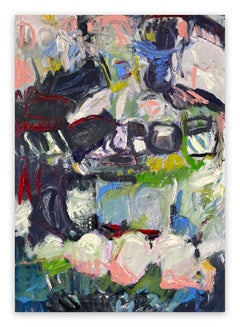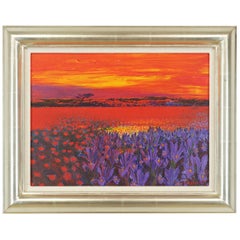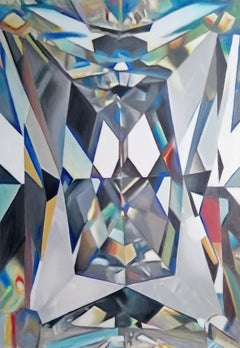Beethoven While Ironing
2010s Abstract Abstract Paintings
Oil, Canvas
2010s Abstract Abstract Paintings
Canvas, Oil
People Also Browsed
Mid-20th Century Mid-Century Modern Paintings
Canvas, Giltwood
2010s Abstract Abstract Paintings
Canvas, Oil
Antique Early 18th Century Japanese Edo Paintings and Screens
Silk, Paper
Early 20th Century Dutch Art Deco Paintings
Wood
Antique Early 19th Century Japanese Edo Paintings and Screens
Silk
20th Century Italian Modern Paintings
Paint
2010s Abstract Abstract Paintings
Canvas, Oil
Vintage 1930s Austrian Art Deco Paintings
Canvas
Late 20th Century British Paintings
Canvas
2010s Abstract Abstract Paintings
Oil, Canvas
Vintage 1970s American Mid-Century Modern Paintings
Maple, Paint
2010s American Paintings
Acrylic
2010s Abstract Abstract Paintings
Canvas, Oil
Vintage 1970s American Mid-Century Modern Paintings
Maple, Paint
Mid-20th Century French Paintings
Vintage 1960s Swedish Modern Paintings
Other
A Close Look at abstract Art
Beginning in the early 20th century, abstract art became a leading style of modernism. Rather than portray the world in a way that represented reality, as had been the dominating style of Western art in the previous centuries, abstract paintings, prints and sculptures are marked by a shift to geometric forms, gestural shapes and experimentation with color to express ideas, subject matter and scenes.
Although abstract art flourished in the early 1900s, propelled by movements like Fauvism and Cubism, it was rooted in the 19th century. In the 1840s, J.M.W. Turner emphasized light and motion for atmospheric paintings in which concrete details were blurred, and Paul Cézanne challenged traditional expectations of perspective in the 1890s.
Some of the earliest abstract artists — Wassily Kandinsky and Hilma af Klint — expanded on these breakthroughs while using vivid colors and forms to channel spiritual concepts. Painter Piet Mondrian, a Dutch pioneer of the art movement, explored geometric abstraction partly owing to his belief in Theosophy, which is grounded in a search for higher spiritual truths and embraces philosophers of the Renaissance period and medieval mystics. Black Square, a daringly simple 1913 work by Russian artist Kazimir Malevich, was a watershed statement on creating art that was free “from the dead weight of the real world,” as he later wrote.
Surrealism in the 1920s, led by artists such as Salvador Dalí, Meret Oppenheim and others, saw painters creating abstract pieces in order to connect to the subconscious. When Abstract Expressionism emerged in New York during the mid-20th century, it similarly centered on the process of creation, in which Helen Frankenthaler’s expressive “soak-stain” technique, Jackson Pollock’s drips of paint, and Mark Rothko’s planes of color were a radical new type of abstraction.
Conceptual art, Pop art, Hard-Edge painting and many other movements offered fresh approaches to abstraction that continued into the 21st century, with major contemporary artists now exploring it, including Anish Kapoor, Mark Bradford, El Anatsui and Julie Mehretu.
Find original abstract paintings, sculptures, prints and other art on 1stDibs.
Finding the Right abstract-paintings for You
Bring audacious experiments with color and textures to your living room, dining room or home office. Abstract paintings, large or small, will stand out in your space, encouraging conversation and introducing a museum-like atmosphere that’s welcoming and conducive to creating memorable gatherings.
Abstract art has origins in 19th-century Europe, but it came into its own as a significant movement during the 20th century. Early practitioners of abstraction included Wassily Kandinsky, although painters were exploring nonfigurative art prior to the influential Russian artist’s efforts, which were inspired by music and religion. Abstract painters endeavored to create works that didn’t focus on the outside world’s conventional subjects, and even when artists depicted realistic subjects, they worked in an abstract mode to do so.
In 1940s-era New York City, a group of painters working in the abstract mode created radical work that looked to European avant-garde artists as well as to the art of ancient cultures, prioritizing improvisation, immediacy and direct personal expression. While they were never formally affiliated with one another, we know them today as Abstract Expressionists.
The male contingent of the Abstract Expressionists, which includes Jackson Pollock, Willem de Kooning and Robert Motherwell, is frequently cited in discussing leading figures of this internationally influential postwar art movement. However, the women of Abstract Expressionism, such as Helen Frankenthaler, Lee Krasner, Joan Mitchell and others, were equally involved in the art world of the time. Sexism, family obligations and societal pressures contributed to a long history of their being overlooked, but the female Abstract Expressionists experimented vigorously, developed their own style and produced significant bodies of work.
Draw your guests into abstract oil paintings across different eras and countries of origin. On 1stDibs, you’ll find an expansive range of abstract paintings along with a guide on how to arrange your wonderful new wall art.
If you’re working with a small living space, a colorful, oversize work can create depth in a given room, but there isn’t any need to overwhelm your interior with a sprawling pièce de résistance. Colorful abstractions of any size can pop against a white wall in your living room, but if you’re working with a colored backdrop, you may wish to stick to colors that complement the decor that is already in the space. Alternatively, let your painting make a statement on its own, regardless of its surroundings, or group it, gallery-style, with other works.
- 1stDibs ExpertSeptember 25, 2019
Unlike cast iron, wrought iron is not brittle and will bend rather than break. Wrought ironwork is produced with a hammer and anvil and tends to be more intricate than cast ironwork, which is characterized by repetitive designs that can be carved into a wooden pattern and cast.
- What era are iron beds from?1 Answer1stDibs ExpertMarch 22, 2022The earliest iron beds trace back to 17th-century Italy, where infestations of bed bugs and moths led crafters to produce handmade metal furniture for bedrooms. In the late 1800s, the beds came into fashion again because many people thought they were simpler to clean. You'll find a variety of antique iron beds on 1stDibs.
- What is wrought-iron furniture?1 Answer1stDibs ExpertSeptember 25, 2019
Wrought iron is a highly refined iron alloy that is tough, malleable, corrosion resistant and easily welded. It is no longer produced on a commercial scale. Many items, including garden furniture, referred to today as wrought iron are actually made of mild steel. They are called wrought iron because they resemble objects that in the past were “wrought” by hand, rather than cast.
- What are cast iron columns?1 Answer1stDibs ExpertMay 5, 2023Cast iron columns are vertical supports produced out of cast iron, a material made from iron and alloys with a carbon content of more than two percent. During the 19th century, cast iron columns were used in architecture. Today, they primarily function as decorative objects. Shop a range of cast iron columns on 1stDibs.
- How old are iron doors?1 Answer1stDibs ExpertApril 5, 2022Iron doors were first used around the 10th century during the Middle Ages. Wrought iron doors fortified castles, towns and other high-invasion areas. As the designs and intricacies improved over time, heavily detailed doors became a status symbol for the upper-middle class and places of worship. Shop a selection of iron doors on 1stDibs.
- Are cast iron columns hollow?1 Answer1stDibs ExpertMarch 31, 2023Whether cast iron columns are hollow depends on the piece. Most cast iron columns are hollow due to the manner of crafting, but some are solid. On 1stDibs, find a selection of columns.
- 1stDibs ExpertMarch 22, 2022A cast iron fireplace insert is a firebox that fits into an existing fireplace surround. The insert is made of cast iron, a type of iron that is more than 2 percent carbon. Cast iron is highly durable and very resistant to the effects of heat. You'll find a selection of cast iron fireplace inserts on 1stDibs.
- 1stDibs ExpertAugust 17, 2021Cast iron trivets are used for many things but are especially ideal for slow cooking meat. They can prop up food in Dutch ovens to prevent burning and increase heat distribution.
- 1stDibs ExpertSeptember 25, 2019
No, wrought iron is not stronger than steel.
- 1stDibs ExpertFebruary 17, 2023Yes, you can generally use cast iron as a planter because the material is durable and sturdy. However, you may need to drill drainage holes in a cast iron piece that wasn't intended to function as a planter to allow excess water to exit the vessel. On 1stDibs, find a selection of cast iron planters.
- Do cast iron Firebacks work?1 Answer1stDibs ExpertAugust 24, 2021Yes, cast iron firebacks are quite sturdy and work really well. As they are made of solid iron, it's a challenge to move and place them. Given that, cast iron firebacks are the best protection for the back wall of the fireplace. Find a variety of firebacks on 1stDibs.
- 1stDibs ExpertSeptember 25, 2019
To keep a piece made of cast iron from rusting, place it in a cool, dry space with good air circulation.
- How do I hang a cast iron bell?1 Answer1stDibs ExpertMarch 22, 2022How to hang a cast iron bell depends on the style. Some cast iron bells have loops at the top that you can hang from a hook anchored onto your desired mounting surface. Others have brackets or frames that you can secure with mounting screws. On 1stDibs, shop a selection of cast iron bells.
- 1stDibs ExpertSeptember 25, 2019
Cast iron is stronger than steel.
- 1stDibs ExpertMarch 22, 2022Cast iron doorstops originated in the late 18th century. Osbourn Dursey invented the first doorstop in 1878. Decorative cast iron stops became popular in the 1920s and remained so throughout World War II. On 1stDibs, shop a variety of antique cast iron doorstops.
- Do cast iron tables rust?1 Answer1stDibs ExpertMay 5, 2023Yes, cast iron tables can rust. Pieces are more likely to develop rust when exposed to humidity, such as in bathrooms or outdoor living spaces in coastal areas. Wiping surfaces clean regularly and touching up scratches and chips can reduce the risk of rust. On 1stDibs, shop a selection of cast iron tables.
- 1stDibs ExpertMay 5, 2023One way to tell if wrought iron is vintage is to look for markings that indicate who produced it. Markings may appear on the underside, back and legs of wrought iron furniture. You can then use trusted online resources to determine when the maker was active and producing pieces similar to yours. Consult a certified appraiser or knowledgeable antiques dealer if you can't find markings or have difficulty dating a piece. Shop a variety of wrought iron furniture on 1stDibs.
- 1stDibs ExpertFebruary 13, 2024To tell if wrought iron is Woodard, examine its frame closely. Authentic pieces usually have the Woodard name embossed right onto the metal. Instead of embossing, some pieces display the brand name on a metal tag. For assistance with identifying a piece of wrought iron furniture, seek the help of a certified appraiser or licensed dealer. Explore an assortment of Woodard wrought iron furniture on 1stDibs.
- Are iron pots good for plants?1 Answer1stDibs ExpertMay 5, 2023Whether iron pots are good for plants is a matter of opinion. The biggest advantage of an iron pot is that it’s highly durable. Many people also like the appearance of the metal. On the downside, an iron pot that lacks insulation could overheat plants when exposed to hot weather. In addition, adding water to iron could lead to rusting. Planter liners can reduce the risk of both overheating and rust. Find a range of planters on 1stDibs.
- When were cast iron beds made?1 Answer1stDibs ExpertFebruary 22, 2021Cast iron beds were made starting in the 1850s. These types of beds were handmade until World War I through the use of molds.



